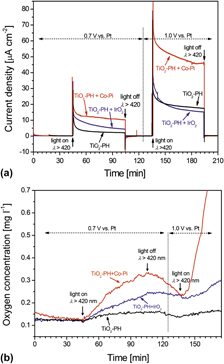Crossref Citations
This article has been cited by the following publications. This list is generated based on data provided by
Crossref.
Mei, Bastian
Byford, Harriet
Bledowski, Michal
Wang, Lidong
Strunk, Jennifer
Muhler, Martin
and
Beranek, Radim
2013.
Beneficial effect of Nb doping on the photoelectrochemical properties of TiO2 and TiO2-polyheptazine hybrids.
Solar Energy Materials and Solar Cells,
Vol. 117,
Issue. ,
p.
48.
Bledowski, Michal
Wang, Lidong
Neubert, Susann
Mitoraj, Dariusz
and
Beranek, Radim
2014.
Improving the Performance of Hybrid Photoanodes for Water Splitting by Photodeposition of Iridium Oxide Nanoparticles.
The Journal of Physical Chemistry C,
Vol. 118,
Issue. 33,
p.
18951.
Aresta, Michele
Dibenedetto, Angela
and
Macyk, Wojciech
2015.
From Molecules to Materials.
p.
149.
Zhang, Qingzhe
Bao, Nan
Zhu, Xiangwei
Ma, Dong
and
Xin, Yanjun
2015.
Preparation and photocatalytic properties of graphene/TiO2 nanotube arrays photoelectrodes.
Journal of Alloys and Compounds,
Vol. 618,
Issue. ,
p.
761.
Khavryuchenko, Oleksiy V.
Wang, Lidong
Mitoraj, Dariusz
Peslherbe, Gilles H.
and
Beranek, Radim
2015.
Enabling visible-light water photooxidation by coordinative incorporation of Co(II/III) cocatalytic sites into organic-inorganic hybrids: quantum chemical modeling and photoelectrochemical performance.
Journal of Coordination Chemistry,
Vol. 68,
Issue. 17-18,
p.
3317.
Kirner, Joel T.
and
Finke, Richard G.
2017.
Water-oxidation photoanodes using organic light-harvesting materials: a review.
Journal of Materials Chemistry A,
Vol. 5,
Issue. 37,
p.
19560.
Orchard, Katherine L.
Hojo, Daisuke
Sokol, Katarzyna P.
Chan, Meng-Ju
Asao, Naoki
Adschiri, Tadafumi
and
Reisner, Erwin
2017.
Catechol–TiO2 hybrids for photocatalytic H2 production and photocathode assembly.
Chemical Communications,
Vol. 53,
Issue. 94,
p.
12638.
Wang, Lidong
Mitoraj, Dariusz
Turner, Stuart
Khavryuchenko, Oleksiy V.
Jacob, Timo
Hocking, Rosalie K.
and
Beranek, Radim
2017.
Ultrasmall CoO(OH)x Nanoparticles As a Highly Efficient “True” Cocatalyst in Porous Photoanodes for Water Splitting.
ACS Catalysis,
Vol. 7,
Issue. 7,
p.
4759.
Oka, Kouki
Tsujimura, Orie
Suga, Takeo
Nishide, Hiroyuki
and
Winther-Jensen, Bjorn
2018.
Light-assisted electrochemical water-splitting at very low bias voltage using metal-free polythiophene as photocathode at high pH in a full-cell setup.
Energy & Environmental Science,
Vol. 11,
Issue. 5,
p.
1335.
Otep, Sultan
Michinobu, Tsuyoshi
and
Zhang, Qichun
2020.
Pure Organic Semiconductor‐Based Photoelectrodes for Water Splitting.
Solar RRL,
Vol. 4,
Issue. 8,
Longchin, Pimchanok
Mitoraj, Dariusz
Reyes, Oliver Mendoza
Adler, Christiane
Wetchakun, Natda
and
Beranek, Radim
2020.
Hybrid photoanodes for visible light-driven water oxidation: the beneficial and detrimental effects of nickel oxide cocatalyst.
Journal of Physics: Energy,
Vol. 2,
Issue. 4,
p.
044001.
Collomb, Marie-Noëlle
Morales, Daniela V.
Astudillo, Catalina N.
Dautreppe, Baptiste
and
Fortage, Jérôme
2020.
Hybrid photoanodes for water oxidation combining a molecular photosensitizer with a metal oxide oxygen-evolving catalyst.
Sustainable Energy & Fuels,
Vol. 4,
Issue. 1,
p.
31.
Gong, Ruihao
Mitoraj, Dariusz
Leiter, Robert
Mundszinger, Manuel
Mengele, Alexander K.
Krivtsov, Igor
Biskupek, Johannes
Kaiser, Ute
Beranek, Radim
and
Rau, Sven
2021.
Anatase-Wrapped Rutile Nanorods as an Effective Electron Collector in Hybrid Photoanodes for Visible Light-Driven Oxygen Evolution.
Frontiers in Chemistry,
Vol. 9,
Issue. ,
Trzciński, Konrad
Szkoda, Mariusz
Zarach, Zuzanna
Sawczak, Mirosław
and
Nowak, Andrzej P.
2022.
Towards spectroscopic monitoring of photoelectrodes: In-situ Raman photoelectrochemistry of a TiO2/prussian blue photoanode.
Electrochimica Acta,
Vol. 404,
Issue. ,
p.
139774.
Gong, Ruihao
Mitoraj, Dariusz
Gao, Dandan
Mundszinger, Manuel
Sorsche, Dieter
Kaiser, Ute
Streb, Carsten
Beranek, Radim
and
Rau, Sven
2022.
A Triad Photoanode for Visible Light‐Driven Water Oxidation via Immobilization of Molecular Polyoxometalate on Polymeric Carbon Nitride.
Advanced Sustainable Systems,
Vol. 6,
Issue. 5,
Gobbato, Thomas
Volpato, Giulia Alice
Sartorel, Andrea
and
Bonchio, Marcella
2023.
A breath of sunshine: oxygenic photosynthesis by functional molecular architectures.
Chemical Science,
Vol. 14,
Issue. 44,
p.
12402.
Braun, Hanna
Mitoraj, Dariusz
Kuncewicz, Joanna
Hellmann, Andreas
Elnagar, Mohamed M.
Bansmann, Joachim
Kranz, Christine
Jacob, Timo
Macyk, Wojciech
and
Beranek, Radim
2023.
Polymeric carbon nitride-based photocathodes for visible light-driven selective reduction of oxygen to hydrogen peroxide.
Applied Catalysis A: General,
Vol. 660,
Issue. ,
p.
119173.
